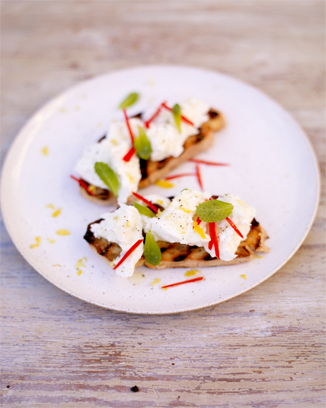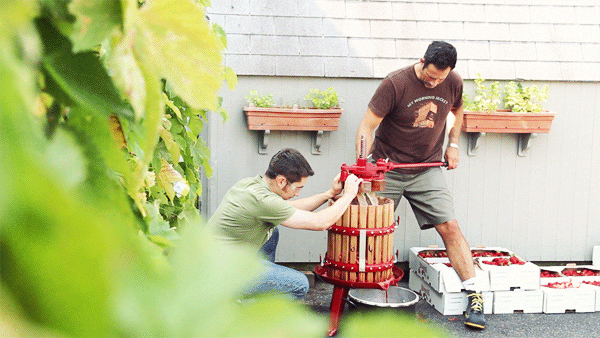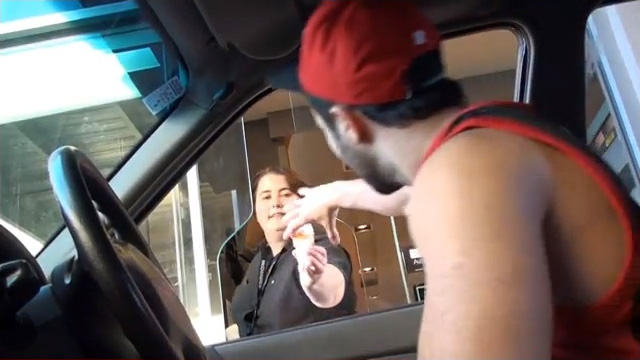Michael: What I think is great about Freshocracy and what I think is good for in any business model is that you’re identifying a problem in your own lives that you would like solved and then you decided to turn that into an actual business.
Christina: Yeah, I started my own blog about a year ago and a supper club out of my house and I would host these dinner parties once a month. I have a very small kitchen as most New Yorkers do and it’s never really phased me because it’s just something I’ve always enjoyed doing. I always made do with the space I had. People would come over and they were always so amazed that I made all this food for so many people with such a small kitchen.
So many people tell me all the time, “Oh I don’t cook, my kitchen’s too small.” Lots of excuses. So we talked about it and realized a lot of us just end up being too busy or use the size of our apartments as an excuse so we just end up ordering takeout or eating out all the time, which is great, there’s lots of great options, I love to do that too, but having grown up always cooking and it was a big part of our family and we wanted to find a way to encourage people todo that again.
I think unfortunately so many of us are used to buying prepackaged things at the grocery store we hardly know how to cook anything from scratch anymore. So the idea came about last summer when Andreas and Ferdinand were over at my apartment and we were just talking over wine about people are more aware of where their food is coming from and I think the trends are moving in the right direction and people want to cook more, they just feel a little lost. We talked about eliminating these pain points and solving it by doing the planning for everyone, doing the measuring out so no one had to buy a whole bottle of turmeric when all you need is a teaspoon for a recipe and really delight people by bringing fantastic meals, things that a really seasonal and fresh and taste the way they’re supposed to taste and keep it simple. That’s how the business got started.
Michael: Interesting. I know that’s the case for my wife and me. I think both of us like to cook and we’re pretty competent at it, but it’s one of those things where you get home, 6 or 7 at night and the last thing you want to do is figure out what I want to cook and do I have all the supplies and that’s where the decision to just get takeout comes from or “Let’s just get sushi.” I think there’s still value to places like Fresh Direct, but I liked your take on it and I liked the simplicity of your business model, like an elevator pitch. I think if your service is too complicated to explain, people are going to get lost and aren’t going to be interested.
I don’t know what your plans are for scaling and how big you want to make Freshocracy, but I though it was interesting how it’s only every two weeks, and it’s only three meals. At least for myself, I would hit a threshold where I’d be like, “Shit, I gotta cook again?!” I think three meals is a good number.How did you come up with that? Was is like, “Well, this is how many meals I would like to cook a week.” and let’s just give it a shot?
Christina: It was a combination of a couple things. We did a trial in September and October for two weeks with basically friends and family in the city. We did three meals then too. We did a big survey after and asked if it felt like too much or too little and everyone, pretty much across the board, thought three was perfect. I think we all like to eat out and have social lives and business obligations – we just have conflicts. So I think if it’s any more than that it would feel like a little too much of something to commit to. That was our same thinking with doing it every other week as well. I think we’re somewhat changing the behavior of people. Having it every other week it almost becomes a fun experience that you look forward to. We’ve gotten a fair amount of feedback from our customers saying they miss it now in the off-week. They eat worse, they eat takeout.
Michael: I was going to say the same thing! It’s kinda like you’re not happy either way. I notice I’m like, “Am I getting a delivery this week?” Then I realize I’m not and I’m bummed, but I think that’s probably a better problem to have than to have people get too much food and cancel because they want to save money.
Christina: Exactly. So we thought if we can start people off by this sounding like a fun experience and something they only have to commit to every other week, then they get more comfortable in the kitchen and they get used to the quality. You know, a lot of people can also be skeptical of it coming in and not knowing if this is really going to be good. We think it is and once people try it and love it, they want more of it. I think once we reach a certain scale, this will become a weekly option.
Michael: How scalable do you think Freshocracy is? You only have your service to particular zip codes on the upper east and upper west sides of Manhattan. Is this something that will evolve over time?
Christina: Absolutely. Our goal is to be able to expand it into other neighborhoods in Manhattan and other boroughs. We just updated our website to capture emails and zip codes of people who are interested in finding out more. By capturing that information we’ll know where the demand is.
The reason we launched on the upper east and upper west side is because we live on the upper west side and all of our farmers are at the market on the upper west side and we operate out of La Marqueta in Harlem. It just made sense logistically to start here.
Michael: You said you’re growing. Do you release numbers as far as how many subscribers you have?
Christina: Yeah. We just delivered over 500 meals. So that for us is a big number, since we just launched at the end of March. We haven’t lost a customer yet and we’re really proud about that since it is a subscription service and certainly people can cancel any time. We know we’re bringing good food and people are happy with it because they’re not leaving. Word of mouth is the best growth mechanism for us.
Michael: One your About page you have five people listed. Is that just the core people or do you have a bigger staff than that?
Christina: So there’s the three of us, who are the founders – Andreas, Ferdinand and myself and we’re involved in everything, soup to nuts, the planning, the buying, all the partnerships, the packaging, the delivering, we do it all. Kelly is our graphic designer, the recipe cards were designed by her and some marketing cards. Matt is our developer and he’s responsible for the website and that’s pretty much it. We just got an intern as well, she’s a college student and really interested in learning about food systems.
Michael: As far as the farmer, that was a big selling point for me. It’s not steroid-injected, massed produced food you deliver. You said you have some relationships with some farmers markets on the west side, but in general, is it hard find local growers? Are there that many or are there a few key ones that are reliable and consistent that you keep going back to?
Christina: I started cultivating these relationships almost a year ago. I started talking to them about this business idea before we did our trial and a lot of them said, “OK, come to us when you’re ready to order something.” Then they did the trial with us, then we spent the fall and winter working on the website and fleshing out the business plan and then launched in March. Since then we’ve been ordering from them on a consistent basis. We’ve been happy with the quality every single time. I talk with them every week on the phone. We have a very close relationship.
I think when we expand, if we outgrow the supply they are able to provide us we’ll look to others, but I don’t think there’s any shortage of providers in the New York-Connecticut-New Jersey area.
Michael: This is kind of random, I was reading your bio page, what is a pullet?
Christina: A pullet is a spring egg. They’re the first eggs that start being laid and I don’t know if you noticed the color of the yolks on egg we gave you for the gnocchi?
Michael: I have to cook that, I haven’t cooked that yet, but I have the egg, I know what you’re talking about.
Christina: These eggs we get from Grazin’ Angus Acres are from really young chickens and they follow the cattle around and basically peck at the poop and eat the larvae from it which is this whole symbiotic relationship.
Michael: Hahaha!
Christina: Yeah, it’s crazy.
Michael: WOW!
Christina: The eggs are really high in omega-3’s and beta carotenes. They’re on the fields eating grass and they in turn, re-fertilize the grass that their grass-fed cows eat. I don’t know if you read The Omnivore’s Dilemma?
Michael: It’s been on my list of books to get.
Christina: When you read it they’ll talk about Polyface farms which was a leader in this area of going back to grass-fed beef and they follow the same methodology. So Grazin’ Angus Acres cattle are on grass pasture all the time and all they eat is grass. Obviously cows eat a lot and there’s not a lot of grass so what happens is they continually move the cattle. They’re in these little fenced-in squares. They chew down all the grass, move them, bring in the chickens after the cows, the chickens will peck around and do their thing, re-fertilize and everything keeps moving around in a circle.
Michael: That’s awesome.
Christina: That’s a very long answer to your question!
Michael: As far as these farmers, are they in danger at all? As far as continuing to do what they do? I get the sense it’s all about scale and it’s very prohibitive to be a farmer if you’re not willing to be a global farmer that just has thousands of acres.
Christina: I think it is a challenge that is sort of shifting. A lot of these industrial farms across the country mass produce. You should read The Omnivore’s Dilemma because it will explain a lot of the problems with industrial farming and when you have thousands and thousands of cattle, it’s all about fattening them up as fast as possible, get ’em slaughtered, get ’em to the store because the longer they’re alive the more costly it is and the cheaper the feed they get give them, the better. That’s why much of meat and poultry is corn-fed in this country because corn is cheap, it’s subsidized. There’s a lot of ramifications to that – to their health and our health. So i think it is a challenge a lot of small farm face, because their product is more labor-intensive, the costs are a bit higher.
What we’re trying to do is make this an affordable option for people. It’s still cheaper than takeout and we’re in a lot of time and effort to provide premium quality meals but it’s allowing us to source directly from the farmer and cut out the middle man and not have to pay any distribution and save us money and we can pass that on to our customers.
Michael: So far you guys are doing a great job. I’m a fan.




